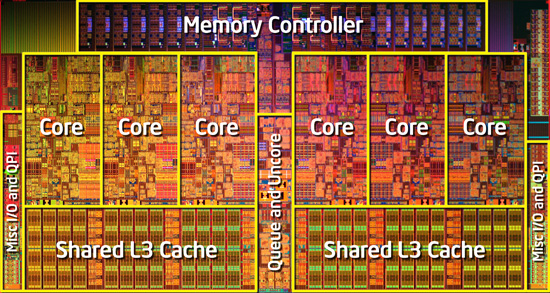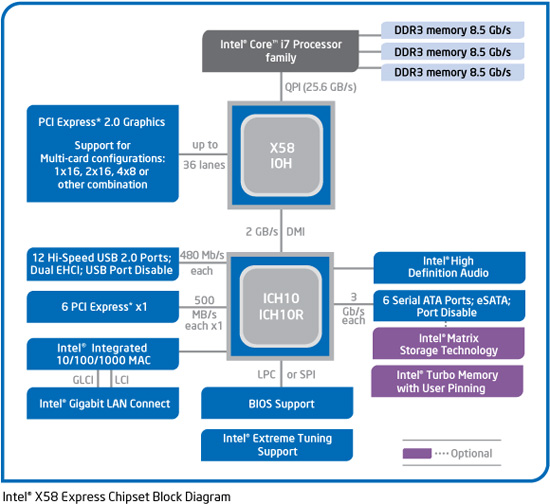The Core i7 980X Review: Intel's First 6-Core Desktop CPU
by Anand Lal Shimpi on March 11, 2010 12:00 AM EST- Posted in
- CPUs
A 12MB L3 Cache: 50% Larger, 14% Higher Latency
Gulftown sticks to Ronak’s 2MB of L3 per core rule and has a full, 12MB shared L3 cache that’s accessible by any or all of the six cores. It’s actually because of the large unified L3 cache that performance in applications that don’t use all six cores can be higher than quad-core Core i7s.

Nehalem

Gulftown
The added cache does come at the expense of higher access latency. Nehalem and Lynnfield had a 42-cycle 8MB L3, Gulftown has a 48 cycle 12MB L3. A 14% higher latency for a 50% increase in size. Not an insignificant penalty, but a tradeoff that makes sense.
Identical Power Consumption to the Core i7 975
Raja has been busy with his DC clamp meter measuring actual power consumption of CPUs themselves rather than measuring power consumption at the wall. The results below compare the actual power draw of the 32nm Core i7 980X to the 45nm Core i7 975. These values are just the CPU itself, the rest of the system is completely removed from the equation:
| CPU | Intel Core i7 980X | Intel Core i7 975 |
| Idle | 6.3W | 6.3W |
| Load | 136.8W | 133.2W |
Thanks to power gating, both of these chips idle at 6.3W. That's ridiculous for a 1.17B transistor chip. Under full load, the two are virtually identical - both drawing around 136W.
Westmere Goodness
The Core i7 980X is the first LGA-1366 processor based on Intel’s Westmere architecture, but unlike Clarkdale it does not have an on-die PCIe controller or on-package graphics. If anything, Gulftown really looks like a 6-core, 32nm version of Bloomfield rather than a scaled up Clarkdale. The similarities to Bloomfield extend all the way to the memory controller. Gulftown only officially supports three channels of DDR3-1066 memory, not 1333MHz like Lynnfield or Clarkdale. Of course running DDR3-1333 memory is possible, but the memory controller is technically operating out of spec at that frequency.

The processor does retain the Westmere specific features. The first Core i7 did not power gate its L3 cache, Lynnfield added it and Gulftown has it as well. While Mainly improved power efficiency and AES-NI instructions. I looked at the performance improvement offered by AES-NI acceleration in our Clarkdale review. If you use BitLocker or do a lot of archive encryption/decryption, you'll appreciate Gulftown's AES-NI.










102 Comments
View All Comments
Anand Lal Shimpi - Thursday, March 11, 2010 - link
That depends on the board I believe. Intel's DX58SO may not post without the BIOS update.Take care,
Anand
Jammrock - Thursday, March 11, 2010 - link
One small title error. Intel's Xeon X7000-series CPUs are the first hex-core processors from Intel. Those are server only, but they are out there.http://ark.intel.com/Product.aspx?id=36947&cod...">http://ark.intel.com/Product.aspx?id=36...16M+Cach...
Gulftown is the first desktop hex-core though.
Anand Lal Shimpi - Thursday, March 11, 2010 - link
Corrected :)Take care,
Anand
artifex - Thursday, March 11, 2010 - link
3x cores and threads for less than 2x the TDP of their dual cores? sexy!Isaac the k - Thursday, March 11, 2010 - link
I must say, I do find this rather exciting.But since I'm running a poorly threaded data-simulation app with extremely high throughput, I'm debating whether the extra latency vs. the larger shared cache could potentially harm performance.
If it wouldn't, I might actually request one for what my office is doing right now...
mikeblas - Thursday, March 11, 2010 - link
Aren't the Xeon E7450, Xeon L7455, and Xeon X7460 all six-core Intel processors that were released before this processor?semo - Thursday, March 11, 2010 - link
If I understand this right Nahalem is the name of the micro architecture and not any CPU in particular. On page 2, the first die shot is captioned Nehalem. Shouldn't it be Bloomfield?BTW Anand, you are doing a good job demystifying desktop products but the mobile space is even worse
arandale http://ark.intel.com/ProductCollection.aspx?codeNa...">http://ark.intel.com/ProductCollection.aspx?codeNa... vs clarkdale http://ark.intel.com/ProductCollection.aspx?codeNa...">http://ark.intel.com/ProductCollection.aspx?codeNa...
vPro is even more confusing. E.g. AMT KVM is supposed to work on AMT 6.0 + on chip GPU yet the i3 don't apply... or the i5-661 http://communities.intel.com/community/openportit/...">http://communities.intel.com/community/...ote-cont...
it would be useful if we could get some articles on mobile chips and/or vPro
iwodo - Thursday, March 11, 2010 - link
Waiting for Sandy Bridge- which will hopefully be the true successor of Core 2 Duo.PCI - Express 3.0, SATA 3.0, USB 3.0 ( Light Peak will be even better ), Bluetooth 4.0.
AnnonymousCoward - Saturday, March 13, 2010 - link
Light Peak is kinda dumb...I think that's just multi-lane USB3/PCIe, and using light instead of wires is pointless since no one needs really long point-to-point cables. Apple just wants it since they're all about marketing new flashy things. USB3 could just as easily use as many lanes as you want, but it'd be unnecessarily expensive since 1 lane at 5Gbps is much faster than anything.Pessimism - Thursday, March 11, 2010 - link
This is not intel's first 6 core CPU. The 6 core Xeon 7400 was announced in 2008.